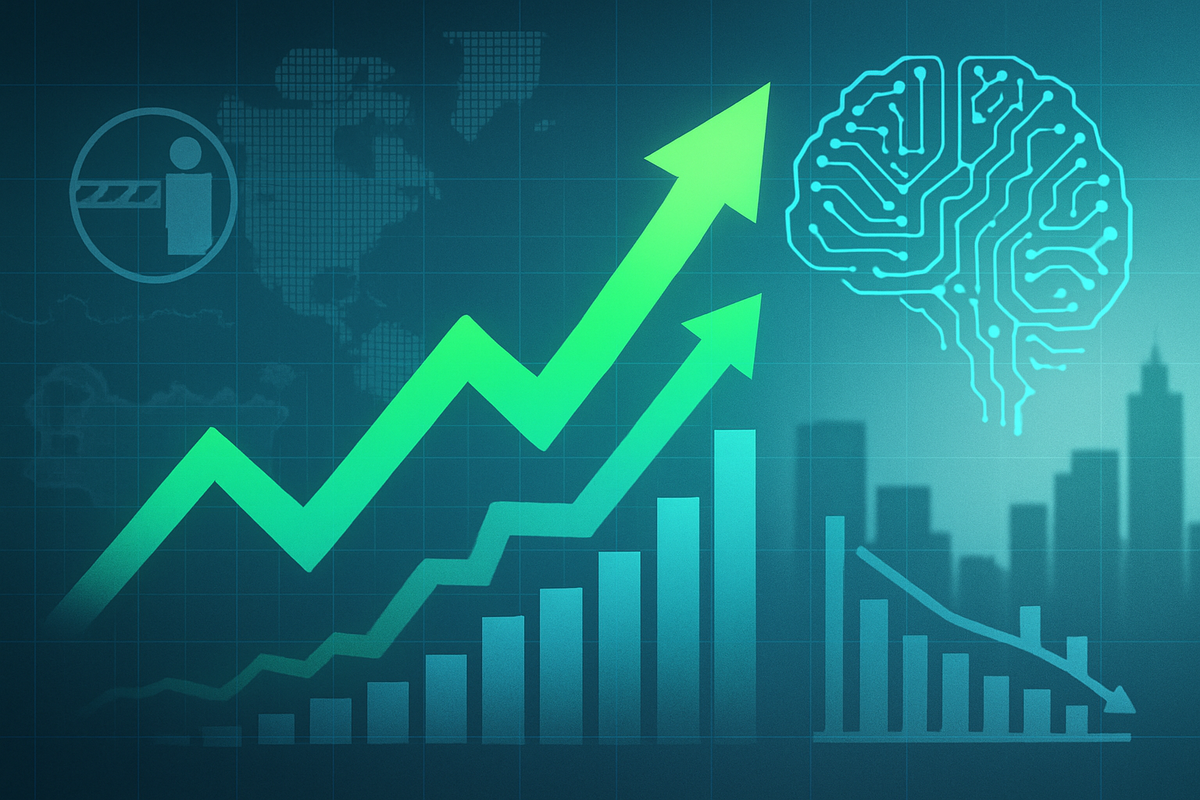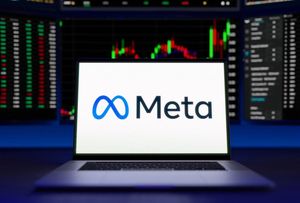
The financial world finds itself in a peculiar state as the stock market continues its upward trajectory, seemingly impervious to significant economic headwinds. Despite a landscape marred by escalating tariffs and a discernible weakening in the labor market, investor confidence, fueled by the transformative power of artificial intelligence and strategic corporate adaptability, has kept equity valuations buoyant. This resilience presents a fascinating divergence between traditional economic indicators and market performance, challenging conventional wisdom and prompting a deeper look into the forces at play.
As of October 20, 2025, the market's steadfast ascent has become a defining characteristic of the current economic cycle. The interplay of aggressive trade policies, a cooling job market, and unprecedented technological advancements creates a complex environment where traditional economic pressures are offset by a forward-looking market sentiment. Investors appear to be betting on future growth and corporate ingenuity, even as the immediate economic picture presents a more challenging narrative.
A Turbulent Economic Tapestry: Tariffs and Labor Market Woes
The period leading up to late 2025 has been characterized by a series of aggressive tariff implementations by the U.S. government, primarily under the Trump administration, which have introduced significant volatility into global trade and supply chains. From January to April 2025, the average applied U.S. tariff rate dramatically surged from 2.5% to an estimated 27%, marking the highest level in over a century. This sharp increase initially caused market instability, with a notable decline in February 2025.
Specific tariff actions included a 25% levy on most Canadian imports and 10% on energy products, alongside a 25% tariff on Mexican imports in February 2025. A 10% tariff on all Chinese goods, later increased to 20% in March, further escalated trade tensions. March 21, 2025, dubbed "Liberation Day," saw President Trump announce plans for large-scale tariffs, immediately heightening market volatility. This culminated in a global stock market crash on April 2, 2025, following announcements of a universal 10% tariff and a 25% tariff on imported cars, marking the largest global market decline since the 2020 crash. The universal 10% tariff officially took effect on April 5, 2025. A temporary reprieve on April 9, 2025, with a 90-day reduction to 10% on all tariffs except those against China, sparked a significant stock market rally. By May 12-14, 2025, the U.S. and China agreed to a 90-day trade deal, lowering U.S. tariffs on most Chinese imports from 145% to 30%, and Chinese retaliatory tariffs from 125% to 10%. However, this was followed by further escalations, including increased tariffs on steel and aluminum to 50% on June 4, 2025, and a 35% tariff on Canadian goods and a 50% tariff on copper products taking effect in early August. India also faced an additional 25% tariff (totaling 50%) in late August due to its trade with Russia, and the de minimis exemption, allowing packages under $800 to enter duty-free, was ended. By September 2025, the average applied U.S. tariff rate was estimated at 17.9%, generating over $30 billion per month in revenue, yet still contributing to market volatility.
Simultaneously, the U.S. labor market has shown clear signs of softening. Nonfarm payroll gains averaged a mere 75,000 per month from January to August 2025, a stark contrast to the 168,000 in the previous year. The Bureau of Labor Statistics also revised prior year job growth estimates downwards by half. Hiring activity has steadily cooled, with the rate of job growth slowing from a peak of 0.36% in August 2022 to 0.09% in September 2025, impacting all age groups, especially younger workers. The U.S. unemployment rate, after holding steady between 4.0% and 4.2% since May 2024, rose to 4.2% in July 2025 and further to 4.3% in August 2025, its highest point since October 2021. A concerning trend is the slight but steady increase in long-term unemployment, unusual during an economic expansion. Worker bargaining power has also weakened significantly, with quits, new hires, and job openings returning to pre-pandemic levels. The ongoing government shutdown in October 2025 has further clouded the real-time picture of the labor market, delaying the release of crucial official data.
Companies Navigating the Crosscurrents: Winners and Losers
The dual pressures of high tariffs and a weakening labor market have created a complex environment for public companies, leading to a clear division between those poised to win and those facing significant challenges. Companies with robust global supply chains and a reliance on imported goods have been particularly vulnerable to tariff hikes. Sectors such as technology, manufacturing, and consumer goods, which often depend on international components and markets, have experienced direct impacts on their input costs and profitability. Goldman Sachs (NYSE: GS) estimated that every five-percentage-point increase in U.S. tariffs could reduce S&P 500 earnings per share by 1-2%.
However, many multinational corporations have demonstrated remarkable adaptability. Faced with increased import costs, companies have strategically adjusted their supply chains, seeking alternative sourcing countries to mitigate the impact of tariffs. There is evidence of a decline in imports from China and a corresponding increase from Mexico, indicating a significant shift in global manufacturing footprints. Some businesses have also engaged in "early buying" to secure inventories at lower costs and have absorbed certain price increases to avoid multiple price hikes for consumers, thereby protecting market share. Companies with strong domestic production capabilities or those that can easily pivot their sourcing stand to gain, while those heavily entrenched in tariff-affected regions face pressure to innovate or restructure.
The weak labor market, while potentially signaling broader economic slowdown, has also had a nuanced impact. For some companies, particularly those in sectors less reliant on consumer discretionary spending or those benefiting from lower labor costs, the softening market could translate into reduced wage pressures and improved margins. However, for businesses that thrive on robust consumer spending and a strong employment base, a weakening labor market could signal reduced demand. Companies that have heavily invested in automation and artificial intelligence (AI) are particularly well-positioned, as these technologies can offset the impact of higher labor costs or a scarcity of skilled workers, potentially boosting productivity and profitability regardless of broader labor market conditions. The "AI arms race" has seen companies like Nvidia (NASDAQ: NVDA), Microsoft (NASDAQ: MSFT), and Alphabet (NASDAQ: GOOGL) driving significant investment and growth in the tech sector, underpinning overall market strength.
Broader Significance: A New Economic Paradigm?
The sustained rally in the stock market amidst such pronounced economic challenges hints at a potentially new economic paradigm, characterized by a significant divergence between "Wall Street" and "Main Street." While Main Street grapples with a slowing economy, including tariff-induced price increases and a cooling labor market, Wall Street, particularly large growth stocks, continues to thrive. This disconnect suggests that large corporations, often with diverse revenue streams and less sensitivity to the immediate timing of interest rate adjustments, are performing well enough to mask some of the broader economic weaknesses.
A weaker U.S. dollar has also played a crucial role, benefiting many S&P 500 companies with substantial international sales. A weaker dollar makes U.S. exports cheaper and more competitive globally, thereby boosting the earnings of multinational corporations. This currency dynamic provides a counteracting force to the negative impacts of tariffs for export-oriented businesses.
The artificial intelligence (AI) boom stands out as a major underlying trend driving market resilience. The rapid advancements and widespread adoption of AI, particularly since the launch of OpenAI's ChatGPT in late 2022, have fueled immense investment and growth in the technology sector. This technological revolution is perceived by investors as a long-term growth driver, promising increased efficiency, new products, and entirely new industries. The optimism surrounding AI's transformative potential appears to outweigh concerns about current economic friction.
From a regulatory and policy perspective, the aggressive use of tariffs signals a continued inclination towards protectionist trade policies, which could have long-term implications for global trade agreements and international relations. The Federal Reserve's (FED) monetary policy will also be critical. A weakening labor market could paradoxically be seen as "good news" by investors if it prompts the FED to cut interest rates, lowering borrowing costs for companies and making equities more attractive. Historically, such counter-cyclical monetary policies have often triggered upward movements in stock markets, aiming to stabilize and stimulate the economy, which in turn can bolster investor sentiment.
What Comes Next: Navigating Uncertainty
Looking ahead, the stock market's resilience will likely be tested by the ongoing interplay of trade policy, labor market dynamics, and technological innovation. In the short term, investors will keenly watch for any shifts in tariff policies or further escalations, as these have historically caused immediate market reactions. The resolution of the ongoing government shutdown in October 2025 will also be critical for gaining a clearer picture of the labor market and broader economic health. Any unexpected shifts in inflation or consumer spending, particularly as tariffs may begin to spill over more significantly into services inflation, could also influence market sentiment.
In the long term, companies will need to continue their strategic pivots and adaptations. This includes further diversification of supply chains, increased investment in automation and AI to mitigate labor market challenges, and innovative approaches to product development and market penetration. Companies that can successfully integrate AI into their operations and offerings are likely to find new market opportunities and maintain a competitive edge. The market will also be anticipating the Federal Reserve's next moves regarding interest rates; a sustained period of lower rates could provide continued support for equity valuations.
Potential scenarios include a continued "soft landing" where the economy slows but avoids a deep recession, allowing the stock market to maintain its upward trajectory, albeit with increased volatility. Alternatively, a more pronounced economic downturn, triggered by unforeseen geopolitical events or a more severe impact from tariffs and labor market weakness, could challenge the market's current resilience. Investors should prepare for potential strategic pivots, focusing on companies with strong balance sheets, adaptable business models, and a clear vision for leveraging technological advancements. Market opportunities may emerge in sectors that are less exposed to tariffs or those that can capitalize on the AI revolution, while challenges will persist for businesses heavily reliant on global trade or facing significant labor cost pressures.
Comprehensive Wrap-Up: A Resilient, Evolving Market
The current financial landscape is defined by the extraordinary resilience of the stock market in the face of significant economic headwinds, particularly high tariffs and a weakening labor market. Key takeaways include the market's forward-looking nature, where investor confidence in future growth and the transformative power of artificial intelligence often outweigh current economic anxieties. Corporate adaptability, exemplified by supply chain adjustments and strategic investments, has also played a crucial role in mitigating the impact of trade barriers. The "bad news is good news" phenomenon, where a softening labor market might prompt favorable monetary policy from the Federal Reserve, adds another layer of complexity to this dynamic.
Moving forward, the market will likely continue to be a battleground between traditional economic pressures and new growth drivers. Investors should closely monitor governmental trade policies, the Federal Reserve's monetary decisions, and the ongoing advancements in artificial intelligence. Companies that demonstrate agility, innovation, and a strong strategic vision for navigating these evolving dynamics will be best positioned for success. The divergence between Wall Street and Main Street highlights the importance of understanding the specific drivers of market performance, rather than relying solely on broad economic indicators.
In the coming months, investors should watch for:
- Tariff developments: Any new trade agreements, escalations, or de-escalations.
- Federal Reserve actions: Interest rate decisions and forward guidance based on economic data.
- Labor market data: A clearer picture once the government shutdown resolves, and trends in unemployment and wage growth.
- AI integration: How quickly and effectively companies are adopting and leveraging artificial intelligence.
- Corporate earnings: The ability of companies to maintain profitability amidst cost pressures and demand fluctuations.
This content is intended for informational purposes only and is not financial advice





